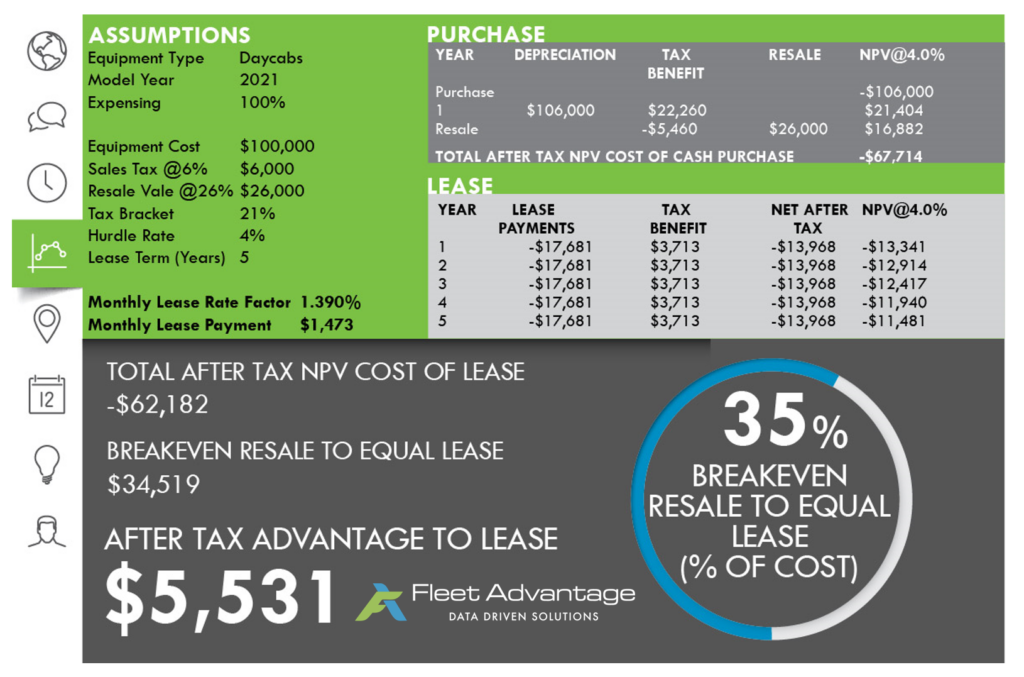Fleet Advantage Life Cycle Cost Management (LCCM) Analysis Shows Truck Lease Structures Offer Greater Financial Savings Compared with Ownership
Operational Savings and Safety Advancements Help Organizations Remain Competitive
Fleet Advantage, a leading innovator in truck fleet business analytics, equipment financing, and life cycle cost management (LCCM)
released today its latest Lease versus Ownership Analysis of heavy-duty truck equipment that shows operational and financial leasing benefits for organizations. The analysis illustrates a significant cost-savings opportunity for organizations that switch to a shorter life cycle leasing procurement strategy.
It is evident by the cash flow in this Lease vs Ownership Analysis that there is an after-tax advantage to leasing tractor equipment. Fleet Advantage analyzed the total costs associated with purchasing an asset, including the upfront cost of the equipment, depreciation expense, tax expense, and the resale of the truck asset at the end of its useful life resulting in an immediate $67,714 cash outflow. In comparison, the total cash outflow associated with leasing a truck asset are the fixed annual costs in the form of lease payments resulting in a net present value of $62,182, resulting in an after-tax advantage of $5,531 toward an organization’s bottom line.
Comparison Assumptions:
- Comparing 2021 model year Day Cab truck on a five-year term costing $100,000
- 100% expensing in the first year of the asset’s useful life
- Resale value of 26% at the end of the asset’s useful life
- Sales tax of 6%
- Federal tax rate of 21%
- Lease rate factor of 1.390%
- Discount rate of 4%*
*The discount rate is a function of the current market forces and, given the current pandemic where interest rates are depressed, it has been lowered to 4% accordingly.
Leasing Offers Financial Benefits for Operations & Safety
The study was performed by Fleet Advantage analysts who constantly monitor and track a large portfolio of trucks for private fleet and for-hire carrier clients, including each truck’s TIPPINGPOINT®, the point at which it costs more to operate a truck as compared to replacing it with a newer model. What’s more, organizations are paying closer attention to their trucks’ safety obsolescence in addition to their economic obsolescence, meaning safety has become a larger reason to upgrade into newer truck technology.
Outlook for Truck Acquisition in 2021
The Equipment Leasing and Finance Association (ELFA) revealed its top 10 equipment acquisition trends for 2021. The group expects an investment of more than $1.8 trillion in capital goods or fixed business investment, such as trucks, in 2021 through a majority of lease programs. ELFA states that “the propensity to finance equipment is higher than it has been over the last two to three years as long-term interest rates have fallen sharply1.”
Furthermore, “Broad-based investment growth is expected across a range of equipment types after plunging to historic lows in Q2/20 including heavy-duty truck equipment, which will get a boost from demand for over-the-road transportation as consumer spending strengthens throughout the year1.”
“Especially during a difficult economy, the historical mindset is for long-term ownership of a truck, but our Life Cycle Cost Management (LCCM) data continually proves that is not beneficial,” said John Rickette, Vice President of Portfolio & Manager of Transaction Management Team at Fleet Advantage. “Shorter life cycles driven by leasing allow for greater financial benefit to investment periods, and allows organizations to constantly replace with newer, safer trucks. All of this provides greater bottom-line savings while remaining competitively positioned in the industry.”
Category: Equipment, Featured, General Update, Management, News, Vehicles












